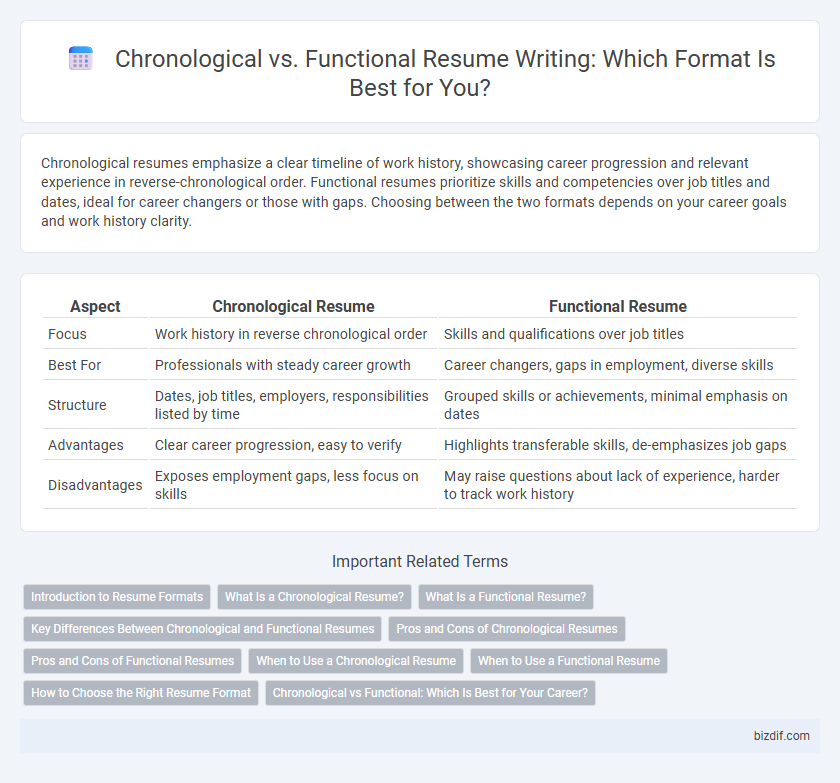Chronological resumes emphasize a clear timeline of work history, showcasing career progression and relevant experience in reverse-chronological order. Functional resumes prioritize skills and competencies over job titles and dates, ideal for career changers or those with gaps. Choosing between the two formats depends on your career goals and work history clarity.
Table of Comparison
| Aspect | Chronological Resume | Functional Resume |
|---|---|---|
| Focus | Work history in reverse chronological order | Skills and qualifications over job titles |
| Best For | Professionals with steady career growth | Career changers, gaps in employment, diverse skills |
| Structure | Dates, job titles, employers, responsibilities listed by time | Grouped skills or achievements, minimal emphasis on dates |
| Advantages | Clear career progression, easy to verify | Highlights transferable skills, de-emphasizes job gaps |
| Disadvantages | Exposes employment gaps, less focus on skills | May raise questions about lack of experience, harder to track work history |
Introduction to Resume Formats
Resume formats primarily include chronological and functional types, each serving unique job-seeking needs. The chronological format highlights a clear timeline of work history, ideal for candidates with consistent employment and career progression. Functional resumes emphasize skills and competencies over dates, benefiting those with gaps in employment or changing career fields.
What Is a Chronological Resume?
A chronological resume lists work experience in reverse chronological order, highlighting job titles, employers, and dates of employment to showcase career progression. This format is ideal for candidates with a strong, continuous work history in the same field, emphasizing stability and growth. Recruiters often prefer chronological resumes because they provide a clear timeline of professional development and achievements.
What Is a Functional Resume?
A functional resume highlights skills and experience over chronological work history, making it ideal for career changers or those with employment gaps. This format organizes information by job functions or skill categories rather than listing positions in order. Employers quickly see relevant competencies, which can improve chances of landing interviews despite unconventional work backgrounds.
Key Differences Between Chronological and Functional Resumes
Chronological resumes emphasize work history by listing job experiences in reverse chronological order, highlighting career progression and stability. Functional resumes prioritize skills and competencies over specific job titles, ideal for career changers or those with gaps in employment. Key differences include the format's focus: chronological resumes showcase a timeline of employment, while functional resumes organize content by skill categories to foreground relevant expertise.
Pros and Cons of Chronological Resumes
Chronological resumes highlight a clear career progression by listing work experience in reverse chronological order, making it easier for employers to track job history and growth. This format is beneficial for candidates with a consistent work background but can expose employment gaps or frequent job changes. However, chronological resumes may not effectively emphasize transferable skills for those changing careers or re-entering the workforce.
Pros and Cons of Functional Resumes
Functional resumes emphasize skills and competencies over chronological work history, making them ideal for career changers or individuals with employment gaps. This format highlights transferable skills but may raise concerns for recruiters unable to quickly assess job tenure and career progression. Candidates risk appearing evasive about their work timeline, potentially leading to reduced trust during the hiring process.
When to Use a Chronological Resume
A chronological resume is ideal for professionals with a consistent work history in the same industry, highlighting career progression and stable employment. It emphasizes recent job titles and achievements in reverse chronological order, making it easier for recruiters to track professional growth. Use a chronological resume when your work experience aligns with the job you're applying for and demonstrates relevant skills and accomplishments.
When to Use a Functional Resume
A functional resume is ideal for emphasizing skills and accomplishments over chronological work history, making it suitable for career changers, recent graduates, or individuals with employment gaps. This format highlights transferable skills relevant to the job rather than specific job titles or dates. Recruiters in industries like technology, creative fields, and consulting often prefer functional resumes when assessing candidates with diverse or non-linear career paths.
How to Choose the Right Resume Format
Selecting the right resume format depends on your work history and career goals; chronological resumes highlight a clear career progression with reverse-chronological job listings, ideal for candidates with consistent employment. Functional resumes emphasize skills and competencies over dates, making them suitable for professionals with employment gaps or career changes. Evaluating your experience and the job requirements ensures the most effective presentation of your qualifications to recruiters.
Chronological vs Functional: Which Is Best for Your Career?
Choosing between a chronological and functional resume depends on your career history and goals. A chronological resume highlights a steady employment timeline, ideal for professionals with consistent work experience in one field, whereas a functional resume emphasizes skills and accomplishments, benefiting those with gaps, career changes, or diverse job roles. Identifying whether your priority is showcasing upward career progression or specific competencies will determine the best format to enhance your job application impact.
Chronological vs Functional Infographic

 bizdif.com
bizdif.com